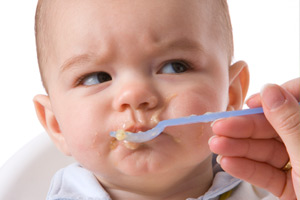Blog Categories
Search Blog
Blog Categories
AboutKidsHealth: Sensitive Gag Reflex: Transition to Solid Foods
Learning to eat solid foods can be a very complex and challenging task. While gagging is considered to be normal at times, if persistent it can be indicative of a bigger issue. AboutKidsHealth published this article a few years back, which outlines the causes of gagging and summarizes some practical tips.
At Boomerang Health, we have a variety of clinicians (occupational therapists and dietitians) who have expertise in feeding related concerns. If you have any questions, or would like to book an appointment, feel free to be in touch.
Some babies and children have problems taking and swallowing food that is not smooth. These children will often do well with smooth pureed (say: PYOOR-aid) foods, such as commercial first baby foods in jars. When they are given pureed foods that are not smooth, they will often gag and sometimes vomit (throw up). As a result, their parents will often go back to the smooth purees, which the child likes.
These children continue to eat only smooth pureed foods and do not have the chance to learn to eat foods with texture. They also do not have the chance to learn to chew. Some children will be able to tolerate food with lumps in their mouth but will gag if they try to swallow lumps. As a result, these children will spit out lumps and only swallow the smooth part of food.
What causes this problem
Children who gag when trying to eat foods that are lumpy or have texture often have a very sensitive gag reflex. The gag reflex helps us to expel food that our bodies feel is unsafe for us to swallow. The gag is usually triggered somewhere on the tongue.
Children with a very sensitive gag reflex tend to gag more easily than other children on food that is not smooth. This often looks very scary, as the child can turn red and appear quite distressed. Sometimes the gagging will lead to vomiting.
The difference between a sensitive gag reflex and a swallowing problem
It is common for parents to think that gagging when eating is caused by a problem with swallowing. However, there is a difference between a sensitive gag reflex and a swallowing problem:
- Children who have a very sensitive gag reflex will gag when new foods are still in their mouth, before they have tried to swallow the food. This can occur when the food is near the front, middle, or back of the mouth.
- Children with a swallowing problem have trouble after the food has been swallowed. They may gag or choke.
Chewing problems can also cause gagging
Children can have problems with textured food because they have trouble chewing:
- Some children have difficulty chewing solid food in order to make it safe to swallow. These children will try to swallow a piece of food before it is properly broken down. This can cause them to gag and sometimes choke. This is often seen when children are first learning to chew.
- Children who have delays in their motor skills will often also have delays in their chewing skills as well.
If your child is gagging with some solids, make sure that he can properly chew the food that he is being given.
How you can help your child with a very sensitive gag reflex
Children who have a very sensitive gag reflex usually need some help to improve. Just going back to offering only smooth foods and hoping that as the child gets older, his feeding will improve, does not always work. Most children with very sensitive gag reflexes need to experience the feeling of texture in their mouth and throat in order to make their gag reflex less sensitive.
Smooth foods with lumps, such as yogurt with pieces of fruit, are often the most difficult for children with a very sensitive gag reflex. This is because the child feels a smooth texture and then the lump is a surprise. This can cause the child to gag.
Tips to help your child tolerate textured food
To make the gag reflex less sensitive and help children tolerate food in their mouth that is not smooth, you can try the following:
- Add texture to the food, but still keep it all the same texture. That is, you can make the food more grainy but with no lumps. You can do this by taking the smooth food that the child likes to eat and adding something like wheat germ or graham cookie crumbs. This will make the food less smooth, but there will be no surprise lumps. You can start off by adding only a very small amount of the wheat germ or graham cookie crumbs. As the child improves, you can add more. This will help the child slowly get used to the feeling of texture in his mouth and throat.
- If your child is able, allow him to feed himself for all or part of the meal. Children with sensitive gags often do better if they can feed themselves.
- Even if your child is not able to tolerate lumpy or textured pureed foods, he may be ready to try solids that dissolve easily, such as baby crackers or cookies. Children with sensitive gag reflexes often do better with solids that dissolve easily, rather than lumpy pureed foods.
- Brushing your child’s teeth will also often help to make his gag less sensitive.
- If your child enjoys putting toys in his mouth, provide teething toys that have bumps and different textures.
If your child continues to have trouble swallowing textured foods, speak to your child’s doctor.
Key points
- Some children will gag or vomit when they are given pureed foods that are not smooth. This is often caused by a very sensitive gag reflex.
- Offering only smooth foods and hoping that the problem will go away does not always work.
- There are a few things you can do to help make your child’s gag reflex less sensitive
Authors: Suzanne Breton, Eyal Cohen, Sherna Marcus, & Irene Ushycky
Original publish date: November 10, 2009
Link to article: www.aboutkidshealth.ca/article?contentid=31&language=English






